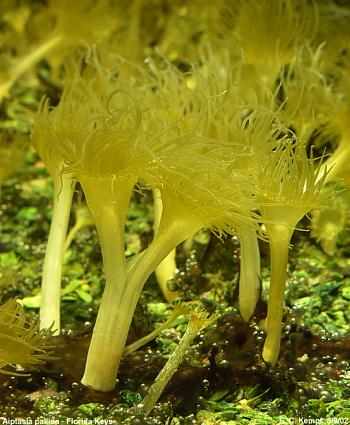
The weed anemone Aiptasia
PHOTO
Aiptasia pallida. Florida Keys. PHOTO: Steve Kempf
Species of the small brown sea anemone Aiptasia, including A. pallida and A. pulchella, are common "weed" organisms in zoo aquaria as well as those of the private hobbyist. This anemone is very well adapted for aquarium life for two reasons.
• It prefers high illumination because much of its nutrition is derived from millions of photosynthetic algal symbionts, called zooxanthellae , that live in the anemone's tissues.
• Its most common form of reproduction is asexual. This asexual reproduction is accomplished by a process called pedal laceration which simply means that small pieces of anemone tissue separate from the anemone as it slowly moves over objects in the aquarium, and each bit is able to grow into a complete new anemone. In small numbers, these anemones add interesting highlights to any tank; however if conditions are right the anemone can proliferate at a very high rate. As a result, regular and time consuming manual removal is often required so aquaria are not overrun by dense populations of Aiptasia.
One effective 'biological control' of this anemone has been an aeolid nudibranch which has been identified as the Mediterranean Berghia verrucicornis, but there is some uncertainty about the identification. See the Berghia verrucicornis - in aquaria Page for further information.
Authorship detailsRudman, W.B., 2002 (March 20) The weed anemone Aiptasia. [In] Sea Slug Forum. Australian Museum, Sydney. Available from http://www.seaslugforum.net/find/aiptasia
Related messages
Re: Berghia verrucicornis - aquarium culture [2]
June 11, 2007
From: Stephen C. Kempf
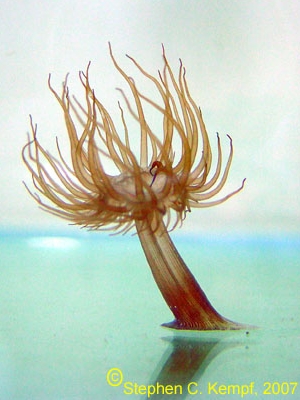
Concerning message #6364:
Bill,
I don't recall if I ever sent the pictures of the "real" Berghia verrucicornis (the one that was called that in the USA but is now Aeolidiella stephanieae ) a few years ago, but just in case I didn't, I'm sending them in a separate message [#19968]. Here are some pictures of its food, the anemone Aiptasia pallida (from the Florida Keys).
Enjoy,
Steve
kempfsc@auburn.edu
Kempf, S.C., 2007 (Jun 11) Re: Berghia verrucicornis - aquarium culture [2]. [Message in] Sea Slug Forum. Australian Museum, Sydney. Available from http://www.seaslugforum.net/find/19966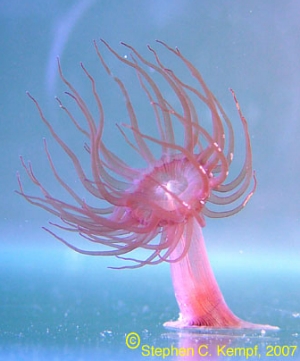
Dear Steve,
Thanks for these extra photos. Its ironic that something so beautiful can cause such havoc in aquaria.
Best wishes,
Bill Rudman
Aiptasia fancier
February 25, 2004
From: Kerry Chase
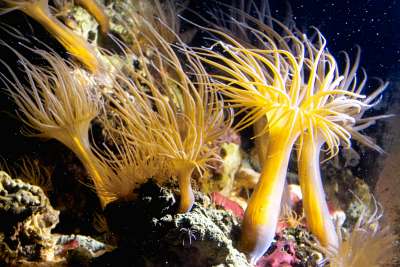
I have a tank dedicated to the cultivation of Aiptasia sp. I find them attractive when mature and quite photogenic.
Kerry Chase, RN
Chase, K., 2004 (Feb 25) Aiptasia fancier. [Message in] Sea Slug Forum. Australian Museum, Sydney. Available from http://www.seaslugforum.net/find/12296Dear Kerry,
Thanks for the nice photo of Aiptasia. From the correspondence on the Forum it seems that your feelings for them are not universally shared.
Cheers
Bill Rudman
Photo of Aiptasia from Florida
March 22, 2002
From: Stephen C. Kempf
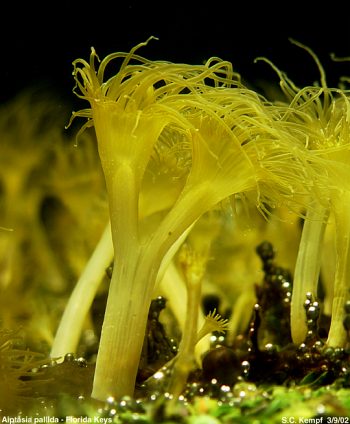

Thought you might enjoy these pictures of Aiptasia pallida from the Florida Keys. Is it the beginning of binary fission, or was this the result of a damaged (split) oral disk? I suspect the latter. For the time being this anemone is alive and well in one of my tanks.
Steve
http://www.auburn.edu/research/hybridoma/
kempfsc@auburn.edu
Kempf, S., 2002 (Mar 22) Photo of Aiptasia from Florida. [Message in] Sea Slug Forum. Australian Museum, Sydney. Available from http://www.seaslugforum.net/find/6473Dear Steve,
Thanks for these photos and the one of its nemesis, Berghia verrucicornis. After all the words, its great to see some pictures.
Bill Rudman
